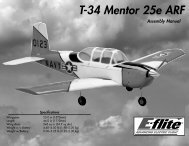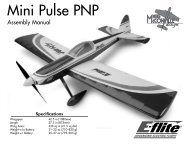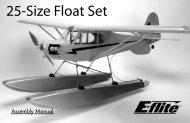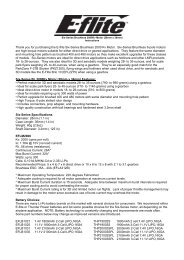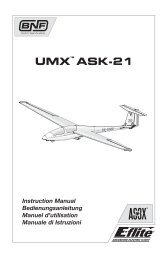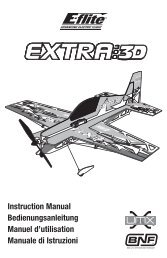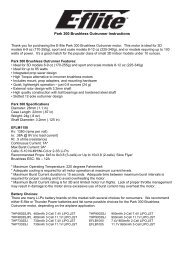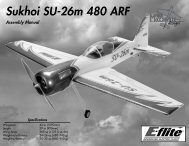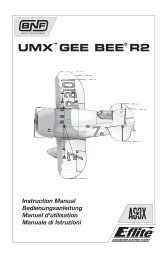P-51B Mustang 32e ARF Manual - Horizon Hobby
P-51B Mustang 32e ARF Manual - Horizon Hobby
P-51B Mustang 32e ARF Manual - Horizon Hobby
You also want an ePaper? Increase the reach of your titles
YUMPU automatically turns print PDFs into web optimized ePapers that Google loves.
Flying Your P-<strong>51B</strong> <strong>Mustang</strong> <strong>32e</strong> <strong>ARF</strong><br />
Now that your <strong>Mustang</strong> is at the field lets go over a<br />
few things first. Is the main battery fully charged Is<br />
the transmitter fully charged Are dual rates set for<br />
the first flight Has the center of gravity been verified<br />
If the answer to all of these questions is yes, then we<br />
are ready for that first flight. The P-<strong>51B</strong> is not slow<br />
and should be flown at a flying field, not a park. Plug<br />
in the flight battery, turn on the transmitter, and turn<br />
on the switch for the radio. Check all control surfaces<br />
and basic motor operation. Check the motor at full<br />
throttle. Pick the model up and cycle the retracts. If<br />
everything is working properly you are ready for<br />
flight.<br />
Taxi the model onto the runway. Set the idle on your<br />
transmitter to a low idle, this will be your flight idle.<br />
For your first flight leave the flaps up on takeoff until<br />
you are familiar with the <strong>Mustang</strong>. Now, applying<br />
power slowly and steering with the rudder to keep the<br />
model straight, the P-<strong>51B</strong> should accelerate quickly<br />
and the tail will rise. As the tail comes up and the<br />
model gains flight speed, you will want to rotate when<br />
you feel comfortable. The P-<strong>51B</strong> should climb out with<br />
authority. Once in the air retract the landing gear.<br />
Climb to a safe altitude and begin to trim the model<br />
out. Once you have the model trimmed out you will<br />
want to get an idea of the flight quality with the flaps<br />
down and slowed down. Once you are happy with this<br />
now we can enjoy the <strong>Mustang</strong>.<br />
You will find the model tracks very well through all<br />
aspects of flight. From high-speed passes to inverted<br />
flight to loops and rolls, you will be flying like a fighter<br />
pilot over Europe in just a few short minutes. If you<br />
have installed the optional pylons and are planning<br />
on dropping the bombs or under-wing tanks let’s do<br />
a pass and clean the bird up. The <strong>Mustang</strong> can be<br />
flown through the entire flight range with the ordinance<br />
on, it will not affect any part of the flight performance.<br />
I normally set up for a pass about 20 feet high at<br />
about 5/8 throttle. Approach the target or drop area,<br />
with the plane level or in a shallow dive, release the<br />
ordinance and fly away. The big key here is DO<br />
NOT WATCH the ordinance fall. You NEED TO FLY<br />
the model. More than one modeler has watched the<br />
bombs continue to fall and the plane continues on into<br />
the ground because no one was flying it. Don’t let this<br />
happen to you.<br />
To set up for landing, drop the flaps and retracts and<br />
enter the downwind pattern for landing. Adjust power<br />
to slow the plane down but keep flying speed. As<br />
you roll onto final approach manage the power and<br />
begin to pull the nose up. The key to a great warbird<br />
landing is to touch down on the wheels and roll down<br />
the runway. That is how the pro’s do it. Before long<br />
you will be enjoying sorties over the field destroying<br />
anything in your path. We hope you enjoy flying the<br />
P-<strong>51B</strong> <strong>Mustang</strong>.<br />
Happy Landings!<br />
Range Test Your Radio<br />
Before each flying session, and especially with a new<br />
model, it is important to perform a range check. It<br />
is helpful to have another person available to assist<br />
during the range check. If you are using a Spektrum<br />
transmitter, please refer to your transmitter’s manual for<br />
detailed instructions on the range check process.<br />
1. With the model resting on the ground, stand 30<br />
paces (approximately 90 feet) away from the model.<br />
<br />
<br />
<br />
2. Face the model with the transmitter in your<br />
normal flying position. Be sure the throttle is in the<br />
full down position and plug the flight battery into<br />
the speed control.<br />
3. As you move the controls, watch to be sure the<br />
airplane’s motor and controls operate smoothly.<br />
You should have total control of the model at 30<br />
paces (90 feet).<br />
4. If control issues exist, call the appropriate<br />
<strong>Horizon</strong> Product Support office (see page 43) or<br />
go to horizonhobby.com to find a local Spektrum<br />
distributor in your country for service if using a<br />
Spektrum radio system.<br />
E-flite P-<strong>51B</strong> <strong>Mustang</strong> <strong>32e</strong> <strong>ARF</strong> Assembly <strong>Manual</strong><br />
41



